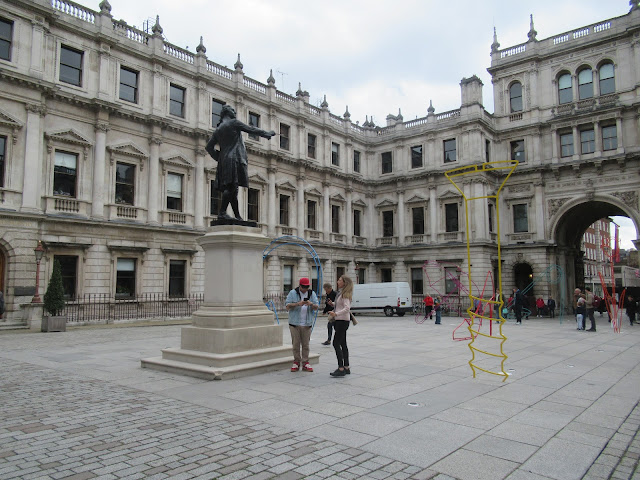Daniel Craig-Martin - Old Masters and Modern Design at the Royal Academy of Arts.
This is the last post on this exhibition that was so enjoyable and thought-provoking. You can see the other three posts on this exhibition here , here and here
Michael Craig-Martin frequently cites artists and works of art that have inspired him. In this post he pays tribute to celebrated works of art by reimagining them in his own visual language. One example is Diego Velazquez's Las Meninas. Artists have been intrigued by the way Velazquez placed the viewer in the position of the Spanish and Queen sitting for their portrait. A much later work, Marcel Duchamp's Fountain (1917), influenced Craig-Martin to pay homage to Duchampian strategy of elevating everyday objects to fine art.
Manet's Dejuener sur L'herbge, (acrylic on aluminium)
One of Craig-Martin's favourite paintings is Georges Seurat's Bathers at Asnieres. Here, he has reimagined this monumental composition using his own visual language of black outline drawing and vivid, flat colour fields. The artist uses colour to highlight elements of the painting such as the factory smokestacks in the background of this scene of leisure.
As with the previous painting, there is no specific blog post for Bathers at Asnieres but you can see the painting here
Las Meminas,2018, (acrylic on aluminium)
To see this painting go here . For some examples of how artists have tried to understand this iconic painting you can go here
Manet's Olympia, 2023, (acrylic on aluminium)
The actual title of Marcel Duchamp's landmark work is The Bride Stripped Bare by Her Bachelors, Even. It shows the erotic encounter between the bride (above) and nine bachelors, trapped in a mechanical apparatus (below). Duchamp used a variety of materials on sheets of glass rather than canvas. In his painting, Craig-Martin plays on the tension of paying homage to Duchamp's materpiece while the original work was a rejection of painting itself.
You can see Duchamp's iconic installation here and here (this blogpost includes other works by Marcel Duchamp)

.JPG)
.JPG)
.JPG)
.JPG)
.JPG)
.JPG)
.JPG)
.JPG)
No comments:
Post a Comment